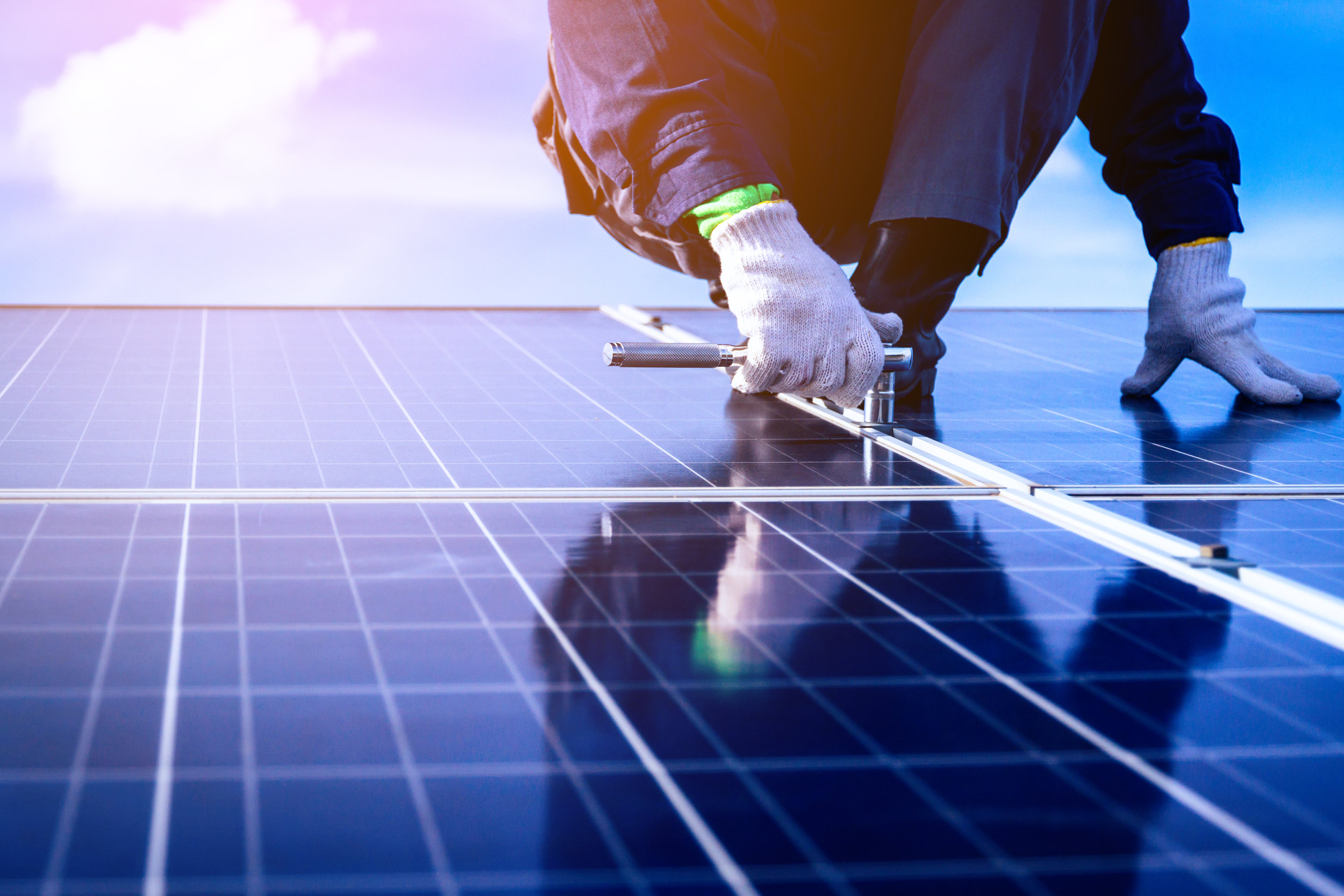
Solar Energy Technician Training Program
OVERVIEW:
This six week, six module course will provide students with the skills and training necessary for entry level positions as Solar PV installers.
Solar Photovoltaic (PV) Installers, also known as PV installers, assemble, install, and maintain solar panel systems on rooftops or other structures.
Program is 4 hours per day, 5 days per week, for 6 weeks. Course is a combination classroom/laboratory.
Employment of solar photovoltaic (PV) installers is expected to grow 105% from 2016 to 2026, much faster than the average for other occupations. This continued growth in the solar industry will yield excellent employment opportunities for qualified individuals, particularly those that complete photovoltaic training courses at a community college or technical school.
Work Setting: Most solar panel installations are done outdoors, but PV installers sometimes work in attics and crawl spaces to connect panels to the electric grid. Installers must also travel to jobsites.
PROGRAM DESCRIPTION:
Our Solar Energy Technician Program prepares individuals to apply basic engineering principles and technical skills in support of engineers and other professionals engaged in developing solar-powered energy systems. Course includes instruction in solar energy principles, energy storage and transfer technologies, testing and inspection procedures, system maintenance procedures, and report preparation.
Other topics include site analysis, system sizing, array configuration, and electricity basics; electrical design characteristics such as wiring, overcurrent protection, and grounding; a detailed look at module and inverter specifications and characteristics; mounting methods for various roof structures and ground mounts; and an introduction to safety, construction management, commissioning and more.
This six week, six module course will provide students with the skills and training necessary for entry level positions as Solar PV installers. Starting with the PV fundamentals, and a solid understanding of various components, system architectures, and applications for PV systems, Students will obtain in-depth knowledge PV Solar. Other topics include site analysis, system sizing, array configuration, and electricity basics; electrical design characteristics such as wiring, overcurrent protection, and grounding; a detailed look at module and inverter specifications and characteristics; mounting methods for various roof structures and ground mounts; and an introduction to safety, construction management, commissioning and more. Upon completion of this course, students will be prepared to take part in one of the fastest growing industries in the world
MODULES: CLOCK HOURS | LECTURE/LABORATORY/EXTERNSHIP/TOTAL
PV 101: PV FUNDAMENTALS | 15/05/00/20
PV 102: PV SYSTEM DESIGN | 15/05/00/20
PV 103: PV GRID TIE SYSTEMS | 15/05/00/20
PV 104: PV STAND ALONE SYSTEMS | 15/05/00/20
PV 105: PV CONSTRUCTION MANAGEMENT | 15/05/00/20
PV 106: PV SYSTEM INTERCONNECTION | 15/05/00/20
TOTAL HOURS | 90/30/00/120
Your Career Starts Here

OUR MISSION
We will deliver unparalleled education and skills training programs for high-demand occupations that result in rewarding careers for all of our students
Our school, instructors and staff are approved and certified by Texas Workforce Commission (TWC) and Career Colleges & Schools of Texas (CCST)
Classes Starting Soon!
Check the schedule to view upcoming dates and times.

Course Objectives:
PV 101 - PV FUNDAMENTALS OBJECTIVES
1. Perform hazard analysis
2. Identify job site hazards
3. Implement ladder safety
4. Implement fall protection plan
5. Item fall protection plan
6. Item execute electrical safety
7. Item select personal protective (PPE)
8. Identify common types of PV system applications for both stand-alone and utility interactive systems with and without energy storage.
9. Understand the fundamentals of electric utility system operations, including generation, transmission, distribution and typical electrical service supplies to buildings and facilities.
10. List the advantages and disadvantages of PV systems compared to alternative electricity generation sources.
11. Define basic terminology, including solar radiation, solar irradiance, solar irradiation, solar insolation, solar constant, air mass, ecliptic plane, equatorial plane, pyranometer, solar declination, solstice, equinox, solar time, solar altitude angle, solar azimuth angle, solar window, array tilt angle, array azimuth angle, and solar incidence angle.
12. Differentiate between solar irradiance (power), solar irradiation (energy), and understand the meaning of the terms peak sun, peak sun hours, and insolation
13. Understand the consequences of array shading and best practices for minimizing shading and preserving array output.
14. Create an energy audit
15. Identify all the PV technologies
16. Identify all the components of a PV Solar System
17. Learn PV system configuration
18. Identify the five key electrical output parameters for PV modules using manufacturer's’ literature (Voc, Isc, Vmp, Imp and Pmp), and label these points on a current-voltage (I-V) curve.
19. Define various performance rating and measurement conditions for PV modules and arrays, including STC, SOC, NOCT, and PTC.
20. Describe the features and benefits of Grid Tied and Stand Alone System
PV 102 – PV SYSTEM DESIGN PERFORMANCE OBJECTIVES:
1. Understand the meaning of basic electrical parameters including electrical charge, current, voltage, power and resistance, and relate these parameters to their hydraulic analogies (volume, flow, pressure, hydraulic power and friction).
2. Describe the function and purpose of common electrical system components, including conductors, conduits/raceways and enclosures, overcurrent devices, diodes and rectifiers, switchgear, transformers, terminals and connectors, grounding equipment, resistors, inductors, capacitors, etc.
3. Identify basic electrical test equipment and its purpose, including voltmeters, ammeters, ohmmeters and watt-hour meters.
4. Demonstrate the ability to apply Ohm’s Law in analyzing simple electrical circuits, and to calculate voltage, current, resistance or power given any other two parameters
5. Identify basic properties of electrical conductors including materials, size, voltage ratings and insulation coverings and understand how conditions of use, such as location, other conductors in the same conduit/raceway, terminations, temperature and other factors affect their ampacity, resistance and corresponding overcurrent protection requirements.
6. Identify customer needs, concerns, and expectations
7. Identify factors to consider in a preliminary assessment, including the local solar resource, environmental conditions, and building code and utility interconnection requirements
8. Explain factors considered in identifying appropriate array locations
9. Describe methods for conducting a shading analysis
10. Perform a site analysis
11. Beginning with PV module DC nameplate output, list the de-rating factors and other system losses, and their typical values, and calculate the resulting effect on AC power and energy production, using simplified calculations, and online software tools including PVWATTS
12. Understand the importance of nameplate specifications on PV modules, inverters and other equipment on determining allowable system voltage limits, and for the selection and sizing of conductors, overcurrent protection devices, disconnect means, wiring methods and in establishing appropriate and safe interfaces with other equipment and electrical systems.
13. For a specified PV module and inverter in a simple utility-interactive system, determine the maximum and minimum number of modules that may be used in source circuits and the total number of source circuits that may be used with a specified inverter, depending upon the expected range of operating temperatures, the inverter voltage windows for array maximum power point manufactures’ online string sizing software tools.
14. Design a roof top PV solar system
15. Design a ground mount PV solar system
16. Perform PV system sizing calculations for major components
17. Perform system sizing
PV 103 - SOLAR GRID TIE SYSTEMS PERFORMANCE OBJECTIVES:
1. Identify the advantages and disadvantages of a grid tied system
2. Identify all the equipment and components of a grid tied system
3. Identify the common ways PV arrays are mechanically secured and installed on the ground, to building rooftops or other structures, including rack mounts, ballasted systems, pole mounts, integral, direct and stand-off roof mounts, sun tracking mounts and for other building-integrated applications
4. Understand the requirements for roofing systems expertise, and identify the preferred structural attachments and weathersealing methods for PV arrays affixed to different types of roof compositions and coverings.
5. Compare and contrast the features and benefits of different PV array mounting systems and practices, including their design and materials, standardization and appearance, applications and installation requirements, thermal and energy performance, safety and reliability, accessibility and maintenance, costs and other factors.
6. Perform the installation of a Roof Top Grid Tied system
7. Describe the purpose and organization of the National Electrical Code book
PV 104 – STAND ALONE SYSTEMS PERFORMANCE OBJECTIVES:
1. Describe the advantages and disadvantages of Stand Alone systems
2. Identify all the equipment and components of a Stand Alone system
3. Understand the basic principles, rationale and strategies for sizing stand-alone
4. PV systems versus utility-interactive PV systems.
5. Given a stand-alone application with a defined electrical load and available solar energy resource, along with PV module specifications, size and configure the PV array, battery subsystem, and other equipment as required, to meet the electrical load during the critical design period
6. Perform the installation a Stand Alone System
7. Identify the major battery components and their functions
8. Differentiate between the basic types and classifications of batteries
9. Understand the operation of batteries and their discharging and charging characteristics
10. Understand major principles and considerations for both designing battery banks and installation
11. Identify the principle functions and features of charge controllers
12. Identify requirements for charge controller applications and installations
13. Demonstrate the knowledge to size a PV system for a Stand Alone system
PV 105 – PV CONSTRUCTION PROJECT MANAGEMENT PERFORMANCE OBJECTIVES:
1. Perform a preliminary site assessment and survey
2. Prepare a proposal
3. Plan an installation
4. Identify the roles and responsibilities of the Project Management team
5. Describe preplanning
6. Describe the CPM construction management process
7. Understand Best Construction Management practice for solar installations both small scale and large.
8. Identify recommended safety practices
9. Identify best PV installation practices
PV 106 - PV SYSTEM INTERCONNECTION, CODE, COMPLIANCE, COMMISSION, TESTING, AND INSPECTIONS PERFORMANCE OBJECTIVES:
1. Identify Interconnection code requirements
2. Demonstrate knowledge of key articles of the National Electrical Code, including Article 690, Solar Photovoltaic Systems.
3. Describe typical maintenance requirements for PV arrays and other system components, including inverters and batteries, etc.
4. Describe the commissioning process for a PV system (small and large)
5. Describe Interconnection compliance
6. Identify the most common types of reliability failures in PV systems and their causes due to the equipment, quality of installation and other factors.
7. Identify all testing required system Interconnection
8. Identify all Inspections required for interconnection
9. Describe the purpose of SCADA and DAS systems
10. Understand basic troubleshooting principles and progression, including recognizing a problem, observing the symptoms, diagnosing the cause and taking corrective actions leading from the system, subsystem to the component level.
11. Identify typical local jurisdiction forms required for interconnection of PV Systems
12. Understand operations and maintenance of a PV solar system
We Accept Funding From The Following Sources for those who qualify:
MYCAA, DARS, NO INTEREST TUITION PAYMENT PLAN AND ACADEMIC LOAN FUNDING AVAILABLE FOR QUALIFIED STUDENTS

The solar industry is growing and there are many companies looking for qualified workers. Lack of technical knowledge is the number 1 issue reported from employers in the solar industry regarding difficulty in hiring.
Most Significant Reason for Reported Difficulty Hiring
*source: Solar Jobs Census 2018 - The Solar Foundation









